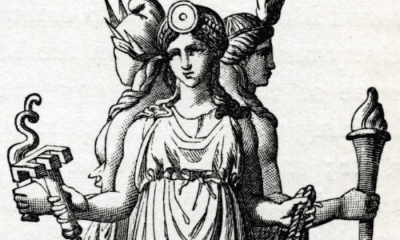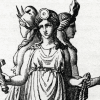Greek
Who is Amphitrite?
Amphitrite was the wife of Poseidon, but what was her importance outside of this role?
Amphitrite was married to the sea god Poseidon, making her his queen and, presumably, an important member of the pantheon.
Despite her position, however, Amphitrite was a relatively minor goddess. She was a nymph, one of fifty daughters of a largely obscure god, with little role outside of her marriage.
It seems incongruous for a god as powerful as Poseidon to choose a wife with such little prominence. Both of his brothers married within their family and had wives who were powerful in their own positions and had their own myths.
Poseidon’s nearly anonymous wife may have once held a higher position in the pantheon, however. Evidence from a handful of texts suggests that Amphitrite was an ancient mother goddess who was diminished over time, but whose importance was never fully erased.
Amphitrite the Sea Queen
Amphitrite was one of the fifty Nereids, sea nymphs whose father was Nereus, The Old Man of the Sea, who ruled over the Aegean.
She was the eldest of the sisters and, according to legend, the most beautiful. Among the nymphs, the Nereids were regarded by some writers as being both the most lovely and the most virtuous.
Amphitrite is not remembered as a nymph, however, but as the Queen of the Mediterranean. She married Poseidon, greatly increasing her own prominence and power.
Although the marriage improved her standing, Amphitrite was reluctant to marry the god of the sea.
Poseidon had tried to arrange a marriage with more powerful Olympian goddesses, including his sisters Demeter and Hestia, in the past but had been unsuccessful. A nymph, however, would be much easier to marry.
The sea god saw Amphitrite dancing on a beach with her sisters and instantly fell in love. While he knew he wanted to make her his wife, Amphitrite had no desire to marry him.
She fled from Poseidon’s advances, swimming as far away as the water would allow. When she reached the primordial river Oceanus, she hid in a bed of seaweed where she hoped he could not find her.
Delphin, the god of dolphins, found her hiding place and told Poseidon where she was.
In some stories, Poseidon seized her and married her by force. In others, he asked the dolphin god to convince her to return to his seas.
Delphin told Amphitrite the many ways that the marriage would benefit her and of Poseidon’s honorable intentions. In this version of the story, Amphitrite was convinced and returned willingly to become Poseidon’s bride.
As the queen of her realm, Amphitrite was revered as a mother goddess. She was not only the mother of Poseidon’s children, but also of all life in the sea.
As such, she was an important figure for the coastal communities that relied on her bounty for their food and trade. As the mother of fish and shellfish, she was the source of nourishment for the fishermen of the coast.
She was sometimes seen as the personification of the Aegean Sea, which served as the main body of water for most of the Greek-speaking world. Prayers spoke of Amphitrite as if she were the sea itself, both thanking her for her bounty and hoping to appease her storms and waves.
In this form she could be a powerful force, capable of the same quick anger and brutal devastation as her husband.
Most often, however, she was simply viewed as the consort of her husband. She was usually shown by his side as a beautiful but inactive wife of a powerful being.
My Modern Interpretation
The marriage of one of the most powerful gods of the pantheon to a simple nymph seems unusual. Zeus and Hades, Poseidon’s brothers, both married more powerful and evenly-matched goddesses.
Some historians, in examining the figure of Amphitrite, have determined that she may not have originally been a nymph at all.
One clue to this involves her association with Nereus. The Old Man of the Sea and his brother, Pontus, were shape-shifting sea gods that seemed to have no defined place in the Greek pantheon.
Some writers considered them to be older gods who took a subordinate position to Poseidon when the Olympians came to power. Historians see a degree of truth in this.
Rather than being primordial sea gods, possibly early sons of Oceanus, they view these characters as hold-overs from pre-Greek mythology. They believe that Nereus and Pontus were the sea gods of an earlier culture that were never fully incorporated into the pantheon of the Mycenean Greeks.
Amphitrite may have thus also been the goddess of an older culture. Whether she was the wife, daughter, or sister of the pre-Greek sea god is unknown, but her power was likely greater than that of a Greek nymph.
When the pre-Greek gods were rewritten as subordinates of Poseidon, however, Amphitrite’s position was lowered as well. A tradition of her marriage to the god of the sea had already been established, but her own importance diminished.
Another hint of this previous position is seen in Amphitrite’s inclusion at the birth of Apollo.
According to ancient sources, Leto’s labor was witnessed by some of the greatest goddesses of Olympus. Rather than being the more readily recognizable younger Olympians, though, there were Titanesses and primordial goddesses who served as mothers to the highest-ranking members of the pantheon.
This included figures like Rhea, the mother of Zeus, and Themis, the mother of the Fates.
While Amphitrite was the mother of sea creatures, her inclusion among the Titanesses seems unusual if she had been born a nymph. This seems to indicate that she once had a more prominent position as a major mother goddess.
Amphitrite appears, therefore, to have been a dominant pre-Greek sea goddess. In her native culture, she was likely seen as a major goddess of fertility.
When Greek-speaking people moved into the region, they incorporated aspects of native religions into their own. Poseidon, who also likely had a non-Greek origin, replaced another sea god as the Olympian pantheon was created.
As the mythology was being developed, Poseidon was paired with Amphitrite in a relatively equal union. As the importance of various gods shifted, however, Amphitrite’s position declined.
While she remained the wife of the sea god, she lost much of her importance outside of this role. Once a powerful goddess in her own right, Amphitrite was recast as a minor nymph who was coerced into a mismatched married with a much more prominent god.
In Summary
Poseidon’s wife Amphitrite was one of fifty daughters born to Nereus, The Old Man of the Sea. As a Nereid nymph, she was a minor goddess of the sea.
Despite this relatively humble origin, however, she attracted the eye of Poseidon. While she resisted the marriage, she eventually became his wife and queen.
Amphitrite was believed to be the mother of all sea life, making her an important deity to coastal fishermen, but was otherwise a largely ignored goddess. She had almost no mythology of her own and was most often shown only as Poseidon’s beautiful companion.
The pairing of one of the most powerful Olympians and a nearly anonymous nymph seems out of place when compared to the marriages of his brothers. But there is evidence that Amphitrite may have once been much more powerful than later mythology indicated.
Hints in texts, including her association with the probably pre-Greek Nereus, indicate that Amphitrite was not always considered to be a minor goddess. Her marriage to the sea god was probably more evenly-matched at one point, but as she was rewritten as a nymph her only remaining importance was as Poseidon’s consort.



